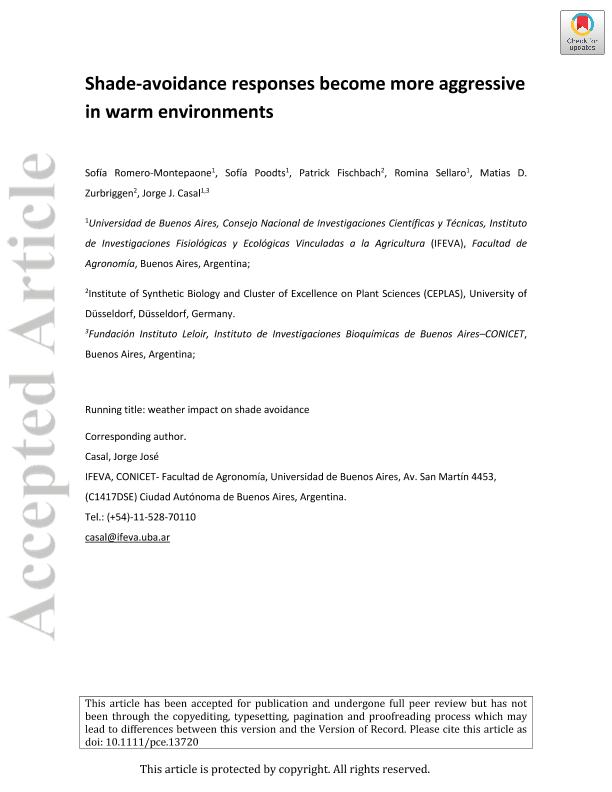Artículo
Shade avoidance responses become more aggressive in warm environments
Romero Montepaone, Sofía Iara ; Poodts, Sofia; Fischbach, Patrick; Sellaro, Romina Vanesa
; Poodts, Sofia; Fischbach, Patrick; Sellaro, Romina Vanesa ; Zurbriggen, Matias Daniel
; Zurbriggen, Matias Daniel ; Casal, Jorge José
; Casal, Jorge José
 ; Poodts, Sofia; Fischbach, Patrick; Sellaro, Romina Vanesa
; Poodts, Sofia; Fischbach, Patrick; Sellaro, Romina Vanesa ; Zurbriggen, Matias Daniel
; Zurbriggen, Matias Daniel ; Casal, Jorge José
; Casal, Jorge José
Fecha de publicación:
04/2020
Editorial:
Wiley Blackwell Publishing, Inc
Revista:
Plant, Cell and Environment
ISSN:
0140-7791
Idioma:
Inglés
Tipo de recurso:
Artículo publicado
Clasificación temática:
Resumen
When exposed to neighbour cues, competitive plants increase stem growth to reduce the degree of current or future shade. The aim of this work is to investigate the impact of weather conditions on the magnitude of shade avoidance responses in Arabidopsis thaliana. We first generated a growth rate database under controlled conditions and elaborated a model that predicts daytime hypocotyl growth as a function of the activity of the main photosensory receptors (phytochromes A and B, cryptochromes 1 and 2) in combination with light and temperature inputs. We then incorporated the action of thermal amplitude to account for its effect on selected genotypes, which correlates with the dynamics of the growth-promoting transcription factor PHYTOCHROME-INTERACTING FACTOR 4. The model predicted growth rate in the field with reasonable accuracy. Thus, we used the model in combination with a worldwide data set of current and future whether conditions. The analysis predicted enhanced shade avoidance responses as a result of higher temperatures due to the geographical location or global warming. Irradiance and thermal amplitude had no effects. These trends were also observed for our local growth rate measurements. We conclude that, if water and nutrients do not become limiting, warm environments enhance the shade avoidance response.
Palabras clave:
GLOBAL WARMING
,
GROWTH
,
PHOTORECEPTORS
,
SHADE AVOIDANCE
,
TEMPERATURE
Archivos asociados
Licencia
Identificadores
Colecciones
Articulos(IFEVA)
Articulos de INST.D/INV.FISIOLOGICAS Y ECO.VINCULADAS A L/AGRIC
Articulos de INST.D/INV.FISIOLOGICAS Y ECO.VINCULADAS A L/AGRIC
Citación
Romero Montepaone, Sofía Iara; Poodts, Sofia; Fischbach, Patrick; Sellaro, Romina Vanesa; Zurbriggen, Matias Daniel; et al.; Shade avoidance responses become more aggressive in warm environments; Wiley Blackwell Publishing, Inc; Plant, Cell and Environment; 43; 7; 4-2020; 1625-1636
Compartir
Altmétricas



